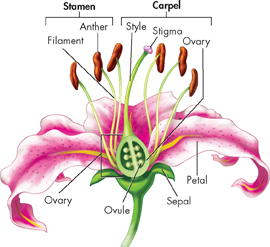24.1 Reproduction in Flowering Plants
 What are flowers?
What are flowers? How does fertilization in angiosperms differ from fertilization in other plants?
How does fertilization in angiosperms differ from fertilization in other plants? What is vegetative reproduction?
What is vegetative reproduction?
stamen • anther • carpel • stigma • pistil • embryo sac • double fertilization • endosperm • vegetative reproduction • grafting
Two-Column Table Construct a two-column table with the headings, Male Gametophyte and Female Gametophyte. As you read, take notes on the characteristics of each type of gametophyte.
THINK ABOUT IT about it What makes a flower beautiful? The symmetry of its petals, its rich colors, and, sometimes, its fragrance. But, at the heart of it, what's behind all this beauty? The answer is, simply, angiosperm sexual reproduction. To a plant, the whole point of a flower is to bring gametes together for reproduction and to protect the resulting zygote and embryo.
The Structure of Flowers
 What are flowers?
What are flowers?
You may think of flowers as decorative objects that brighten our world, and so they are. However, the presence of so many flowers in the world is visible evidence of something else—the stunning evolutionary success of the angiosperms, or flowering plants. The structure of a typical angiosperm flower is shown in Figure 24–1.  Flowers are reproductive organs that are composed of four different kinds of specialized leaves: sepals, petals, stamens, and carpels.
Flowers are reproductive organs that are composed of four different kinds of specialized leaves: sepals, petals, stamens, and carpels.
Sepals and Petals The outermost circle of floral parts contains the sepals (SEE pulz). In many plants, the sepals are green and closely resemble ordinary leaves. Sepals enclose the bud before it opens, and they protect the flower while it is developing. Petals, which are often brightly colored, are found just inside the sepals. The colors, number, and shapes of such petals attract insects and other pollinators to the flower.

FIGURE 24–1 The Parts of a Flower This diagram shows the parts of a typical flower. The flowers of some angiosperm species, however, do not have all the parts shown here.

Table of Contents
- Formulas and Equations
- Applying Formulas and Equations
- Mean, Median, and Mode
- Estimation
- Using Measurements in Calculations
- Effects of Measurement Errors
- Accuracy
- Precision
- Comparing Accuracy and Precision
- Significant Figures
- Calculating With Significant Figures
- Scientific Notation
- Calculating With Scientific Notation
- Dimensional Analysis
- Applying Dimensional Analysis




